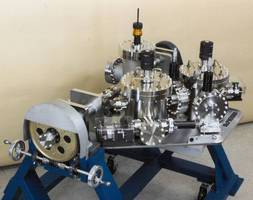VUV-STS features scintillated photomultiplier detector.
Press Release Summary:

Suitable for attosecond spectroscopy and HHG and wavelength calibration applications, Vacuum Ultraviolet Spectral Test System measures optical performance at wavelength for finding optical constants. Measuring samples in two perpendicular planes of incidence, product allows users to check opposite values. Combined with windowless hollow cathode light source, system features mechanically stiff, mounted sample chamber.
Original Press Release:
Deep UV Polarization
McPherson (Chelmsford MA USA) is pleased to announce a new vacuum ultraviolet spectral test system VUV-STS. The new system measures reflectance as a function of angle of incidence. It measures optical performance “at wavelength” and can help determine optical constants. It uses special techniques for measuring non-polarized light and works in the 30 to 160 nanometer wavelength region. Otherwise, and in terms of performance, it is similar to our VUVAS1000 and VUVAS2000 systems. Transmission can be measured too, although it is not appropriate for many materials at these wavelengths. Options exist to extend operation up to 300 nanometers.
This new twist from McPherson helps users test materials, multilayers and coatings “at wavelength in applications like attosecond spectroscopy and HHG, optical design for space applications, wavelength calibration, and thin-film / coating technique design.
Light coming from a monochromator has partial and often variable polarized content. Deep UV and vacuum UV wavelengths present challenges whenever there is polarization. Most laboratory polarizer’s rely on crystalline wavelength transmission. Air spaced Rochon prism polarizer’s built from magnesium fluoride work to wavelength short as 140 nanometers. The VUV-STS solution is to measure samples in two perpendicular planes of incidence. Then average them to negate influence of specific polarization on reflectance (Ip-Is)/(Ip+Is). Measuring in two planes allows us to check the opposite values for each. It finally presents the reflectance for non-polarized incident radiation. This technique can be used for any reflective, diffractive or transmitting sample.
The VUV-STS is a one meter grazing incidence monochromator efficiently coupled to a windowless hollow cathode light source. The sample chamber is mechanically stiff and mounted in widely spaced and well supported bearings. Samples can rotate in two incident planes while under vacuum. Not cycling vacuum improves the quality of measurements. Other features include low noise high gain scintillated photomultiplier detector and easy to use rotation setting and data acquisition software. The McPherson software is for instrument control and does not do film analysis or other post processing – just machine control and data acquisition.
McPherson (Chelmsford, MA USA) manufactures spectrometers and systems to measure and tune wavelengths of light for many disciplines of spectroscopy. For information and to learn more visit www.McPhersonInc.com or call 1-978-256-4512 today.
Contact: Erik Schoeffel,
McPherson, 7A Stuart Road,
Chelmsford MA 01824 USA
Tel. 1-978-256-4512, 1-800-255-1055,
Email Sales@McPhersonInc.com




